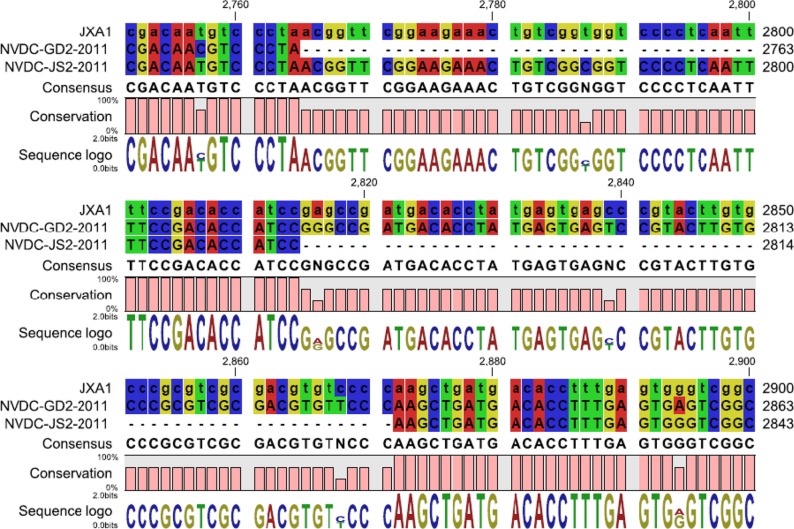Abstract
A highly pathogenic strain of porcine reproductive and respiratory syndrome virus (PRRSV), characterized by a discontinuous 30-amino-acid deletion in its Nsp2-coding region, has been emerging in China since 2006. Here, we report the complete genomic sequence of two novel Chinese virulent PRRSV variants with additional NSP2-gene deletions, which will help us understand the molecular and evolutionary characteristics of PRRSV in Asia.
GENOME ANNOUNCEMENT
Porcine reproductive and respiratory syndrome (PRRS) is one of the most prevalent diseases in swine that causes great economic losses to the swine industry worldwide. Merely within the United States, the annual losses to PRRS are around $560 million (3). The recent pandemics in China of highly pathogenic PRRS virus (HP-PRRSV) have resulted in the deaths of millions of pigs and the loss of billions of Yuan (Chinese currency). This PRRSV variant is characterized by a discontinuous 30-amino-acid deletion (amino acids 481 and 533 to 561) in its Nsp2-coding region (4). With the wide use of modified live attenuated vaccine derived from HP-PRRSV within the past 5 years, fewer outbreaks of HP-PPRSV have been reported. However, field isolates which evaded the vaccination emerged within the immunized pig population. Here, we report two complete genomic sequences of novel virulent Chinese HP-PRRSV, characterized by the additional NSP2 gene deletion, which were isolated from vaccinated pigs.
PRRSV is an enveloped, single-stranded positive-sense RNA virus that belongs to the Arteriviridae family. The 15-kb genome consists of two large open reading frames (ORFs), ORF1a and -1b, that comprise 75% of the viral genome. After being processed from ORF1a protein, Nsp-2 plays an important role in viral replication and pathogenesis (2). The hallmark of the Nsp-2 gene is the flexibility of natural deletions/insertions in field isolates. Two Chinese PRRSVs have been isolated from pigs naturally infected with PRRSV in 2011. Their genomes were generated with PCR using 18 pairs of primers amplifying 18 overlapped fragments of PRRSV (5). The PCR products were purified and cloned into pGEM-T Easy vector (Promega) and sequenced with an automated sequencer (Genetic Analyzer 3730XL; Applied Biosystems). The complete genomic sequences of NVDC-GD2-2011 and NVDC-JS2-2011 are 15,311 and 15,290 nucleotides (nt) long, with a 5′ untranslated region (UTR) of 189 nt, followed by a polyprotein precursor coding sequence and a 3′ UTR of 177 nt. The comparison of NVDC-GD2-2011 (strain A) and NVDC-JS2-2011(strain B) with JXA1 by whole-genome BLAST techniques shows that there are further deletions of 36 and 57 nt, respectively, in the Nsp2 region (see Fig. 1). The genomic similarities between the two novel variants described above and JXA1 are 98.9% (strain A) and 97.1% (strain B).
Fig 1.
Strains NVDC-GD2-2011 and NVDC-JS2-2011 PRRSV show additional deletions, of 36 and 57 nt, respectively, in the Nsp2 region.
Artificially rescued PRRSV with a single 1,209-nt deletion in the Nsp-2 gene has so far been reported with the advent of reverse genetics (1). However, these recombinant viruses are not stable in vivo. The complete genomic sequences described here, of two PRRSV variants isolated from naturally infected pigs, are the first containing additional 36-nt and 57-nt Nsp-2 region deletions, which will contribute to further studies focusing on the molecular evolution of emerging PRRSV strains.
Nucleotide sequence accession numbers.
The complete genome sequences of strains NVDC-GD2-2011 and NVDC-JS2-2011 are available in GenBank under accession numbers JQ715697 and JQ715698.
ACKNOWLEDGMENTS
This work was supported by grants from the National Science and Technology Pillar Program in the 11th 5-year plan period of China (grant 2009BADB4B05), the National Basic Research Program of China (grant 2008FY130100-2), and the Scientific Achievement Transformation Program (grant 2009GB23260435).
REFERENCES
- 1. Faaberg KS, et al. 2010. In vivo growth of porcine reproductive and respiratory syndrome virus engineered nsp2 deletion mutants. Virus Res. 154:77–85 [DOI] [PMC free article] [PubMed] [Google Scholar]
- 2. Fang Y, Snijder EJ. 2010. The PRRSV replicase: exploring the multifunctionality of an intriguing set of nonstructural proteins. Virus Res. 154:61–76 [DOI] [PMC free article] [PubMed] [Google Scholar]
- 3. Neumann EJ, et al. 2005. Assessment of the economic impact of porcine reproductive and respiratory syndrome on swine production in the United States. J. Am. Vet. Med. Assoc. 227:385–392 [DOI] [PubMed] [Google Scholar]
- 4. Tian K, et al. 2007. Emergence of fatal PRRSV variants: unparalleled outbreaks of atypical PRRS in China and molecular dissection of the unique hallmark. PLoS One 2:e526. [DOI] [PMC free article] [PubMed] [Google Scholar]
- 5. Zhou Z., et al. 2011. The epidemic status and genetic diversity of 14 highly pathogenic porcine reproductive and respiratory syndrome virus (HP-PRRSV) isolates from China in 2009. Vet. Microbiol. 150(3–4):257–269 [DOI] [PubMed] [Google Scholar]



